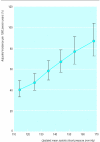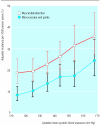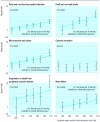Association of systolic blood pressure with macrovascular and microvascular complications of type 2 diabetes (UKPDS 36): prospective observational study - PubMed (original) (raw)
Association of systolic blood pressure with macrovascular and microvascular complications of type 2 diabetes (UKPDS 36): prospective observational study
A I Adler et al. BMJ. 2000.
Abstract
Objective: To determine the relation between systolic blood pressure over time and the risk of macrovascular or microvascular complications in patients with type 2 diabetes.
Design: Prospective observational study.
Setting: 23 hospital based clinics in England, Scotland, and Northern Ireland.
Participants: 4801 white, Asian Indian, and Afro-Caribbean UKPDS patients, whether randomised or not to treatment, were included in analyses of incidence; of these, 3642 were included in analyses of relative risk.
Outcome measures: Primary predefined aggregate clinical outcomes: any complications or deaths related to diabetes and all cause mortality. Secondary aggregate outcomes: myocardial infarction, stroke, lower extremity amputation (including death from peripheral vascular disease), and microvascular disease (predominantly retinal photocoagulation). Single end points: non-fatal heart failure and cataract extraction. Risk reduction associated with a 10 mm Hg decrease in updated mean systolic blood pressure adjusted for specific confounders.
Results: The incidence of clinical complications was significantly associated with systolic blood pressure, except for cataract extraction. Each 10 mm Hg decrease in updated mean systolic blood pressure was associated with reductions in risk of 12% for any complication related to diabetes (95% confidence interval 10% to 14%, P<0.0001), 15% for deaths related to diabetes (12% to 18%, P<0.0001), 11% for myocardial infarction (7% to 14%, P<0.0001), and 13% for microvascular complications (10% to 16%, P<0.0001). No threshold of risk was observed for any end point.
Conclusions: In patients with type 2 diabetes the risk of diabetic complications was strongly associated with raised blood pressure. Any reduction in blood pressure is likely to reduce the risk of complications, with the lowest risk being in those with systolic blood pressure less than 120 mm Hg.
Figures
Figure 1
Incidence rate (95% confidence interval) of any aggregate end point related to diabetes by category of updated mean systolic blood pressure, adjusted for age, sex, and ethnic group, expressed for white men aged 50-54 years at diagnosis and mean duration of diabetes of 10 years
Figure 2
Incidence rates (95% confidence interval) of myocardial infarction and microvascular end points by category of updated mean systolic blood pressure, adjusted for age, sex, and ethnic group expressed for white men aged 50-54 years at diagnosis and mean duration of diabetes of 10 years
Figure 3
Hazard rates (95% confidence intervals as floating absolute risks) as estimate of association between category of updated mean systolic blood pressure and any end point related to diabetes, death related to diabetes, and all cause mortality with log linear scales. Reference category (hazard ratio 1.0) is systolic blood pressure <120 mm Hg; P value reflects contribution of systolic blood pressure to multivariate model. Data adjusted for age at diagnosis, ethnic group, smoking status, presence of microalbuminuria, haemoglobin A1c, high and low density lipoprotein cholesterol, and triglyceride
Figure 4
Hazard rates (95% confidence intervals as floating absolute risks) as estimate of association between category of updated mean systolic blood pressure and myocardial infarction, stroke, microvascular end points, cataract extraction, lower extremity amputation, or fatal peripheral vascular disease and heart failure, with log linear scales. Reference category (hazard ratio 1.0) is systolic blood pressure <120 mm Hg for myocardial infarction, microvascular disease, and cataract extraction and <130 mm Hg for stroke, lower extremity amputation or fatal peripheral vascular disease, and heart failure; P value reflects contribution of systolic blood pressure to multivariate model. Data adjusted for age at diagnosis of diabetes, ethnic group, smoking status, presence of albuminuria, haemoglobin A1c, high and low density lipoprotein cholesterol, and triglyceride
Comment in
- Controlling glucose and blood pressure in type 2 diabetes.
Tuomilehto J. Tuomilehto J. BMJ. 2000 Aug 12;321(7258):394-5. doi: 10.1136/bmj.321.7258.394. BMJ. 2000. PMID: 10938030 Free PMC article. No abstract available. - Glycaemia and vascular effects of type 2 diabetes. UKPDS is not a cohort study and analysis is misleading.
Cruickshank JK. Cruickshank JK. BMJ. 2001 May 19;322(7296):1246; author reply 1247. BMJ. 2001. PMID: 11388184 No abstract available.
Similar articles
- Association of glycaemia with macrovascular and microvascular complications of type 2 diabetes (UKPDS 35): prospective observational study.
Stratton IM, Adler AI, Neil HA, Matthews DR, Manley SE, Cull CA, Hadden D, Turner RC, Holman RR. Stratton IM, et al. BMJ. 2000 Aug 12;321(7258):405-12. doi: 10.1136/bmj.321.7258.405. BMJ. 2000. PMID: 10938048 Free PMC article. - Tight blood pressure control and risk of macrovascular and microvascular complications in type 2 diabetes: UKPDS 38. UK Prospective Diabetes Study Group.
UK Prospective Diabetes Study Group. UK Prospective Diabetes Study Group. BMJ. 1998 Sep 12;317(7160):703-13. BMJ. 1998. PMID: 9732337 Free PMC article. Clinical Trial. - Efficacy of atenolol and captopril in reducing risk of macrovascular and microvascular complications in type 2 diabetes: UKPDS 39. UK Prospective Diabetes Study Group.
UK Prospective Diabetes Study Group. UK Prospective Diabetes Study Group. BMJ. 1998 Sep 12;317(7160):713-20. BMJ. 1998. PMID: 9732338 Free PMC article. Clinical Trial. - Targeting intensive glycaemic control versus targeting conventional glycaemic control for type 2 diabetes mellitus.
Hemmingsen B, Lund SS, Gluud C, Vaag A, Almdal TP, Hemmingsen C, Wetterslev J. Hemmingsen B, et al. Cochrane Database Syst Rev. 2013 Nov 11;(11):CD008143. doi: 10.1002/14651858.CD008143.pub3. Cochrane Database Syst Rev. 2013. PMID: 24214280 Updated. Review. - More Versus Less Intensive Blood Pressure-Lowering Strategy: Cumulative Evidence and Trial Sequential Analysis.
Verdecchia P, Angeli F, Gentile G, Reboldi G. Verdecchia P, et al. Hypertension. 2016 Sep;68(3):642-53. doi: 10.1161/HYPERTENSIONAHA.116.07608. Epub 2016 Jul 25. Hypertension. 2016. PMID: 27456518 Review.
Cited by
- Post Hoc Analysis of SURPASS-1 to -5: Efficacy and Safety of Tirzepatide in Adults with Type 2 Diabetes are Independent of Baseline Characteristics.
De Block C, Peleshok J, Wilding JPH, Kwan AYM, Rasouli N, Maldonado JM, Wysham C, Liu M, Aleppo G, Benneyworth BD. De Block C, et al. Diabetes Ther. 2024 Nov 12. doi: 10.1007/s13300-024-01660-0. Online ahead of print. Diabetes Ther. 2024. PMID: 39531161 - Long-term Impacts of Long COVID: Increased Incidence of Cardiomyopathies, Joint Diseases, and Psychoanxiety Disorders.
Moldovan AF, Ghitea TC, Babeș K, Manole F. Moldovan AF, et al. In Vivo. 2024 Nov-Dec;38(6):3022-3032. doi: 10.21873/invivo.13786. In Vivo. 2024. PMID: 39477428 Free PMC article. - A retrospective cohort study of a community-based primary care program's effects on pharmacotherapy quality in low-income Peruvians with type 2 diabetes and hypertension.
Deaver JE, Uchuya GM, Cohen WR, Foote JA. Deaver JE, et al. PLOS Glob Public Health. 2024 Aug 22;4(8):e0003512. doi: 10.1371/journal.pgph.0003512. eCollection 2024. PLOS Glob Public Health. 2024. PMID: 39173046 Free PMC article. - Advances in electrochemical biosensors employing carbon-based electrodes for detection of biomarkers in diabetes mellitus.
Zuliska S, Maksum IP, Einaga Y, Kadja GTM, Irkham I. Zuliska S, et al. ADMET DMPK. 2024 Jul 25;12(3):487-527. doi: 10.5599/admet.2361. eCollection 2024. ADMET DMPK. 2024. PMID: 39091901 Free PMC article. Review. - 2023 Clinical Practice Guidelines for Diabetes Management in Korea: Full Version Recommendation of the Korean Diabetes Association.
Moon JS, Kang S, Choi JH, Lee KA, Moon JH, Chon S, Kim DJ, Kim HJ, Seo JA, Kim MK, Lim JH, Song YJ, Yang YS, Kim JH, Lee YB, Noh J, Hur KY, Park JS, Rhee SY, Kim HJ, Kim HM, Ko JH, Kim NH, Kim CH, Ahn J, Oh TJ, Kim SK, Kim J, Han E, Jin SM, Bae J, Jeon E, Kim JM, Kang SM, Park JH, Yun JS, Cha BS, Moon MK, Lee BW. Moon JS, et al. Diabetes Metab J. 2024 Jul;48(4):546-708. doi: 10.4093/dmj.2024.0249. Epub 2024 Jul 26. Diabetes Metab J. 2024. PMID: 39091005 Free PMC article. No abstract available.
References
- Klein R. Hyperglycemia and microvascular and macrovascular disease in diabetes. Diabetes Care. 1995;18:258–268. - PubMed
- Standl E, Balletshofer B, Dahl B, Weichenhain B, Stiegler, Hormann A, et al. Predictors of 10-year macrovascular and overall mortality in patients with NIDDM: the Munich general practitioner project. Diabetologia. 1996;39:1540–1545. - PubMed
- Hanefeld M, Fischer S, Julius U, Schulze J, Schwanebeck U, Schmechel H, et al. Risk factors for myocardial infarction and death in newly detected NIDDM: the diabetes intervention study, 11-year follow-up. Diabetologia. 1996;39:1577–1583. - PubMed
Publication types
MeSH terms
LinkOut - more resources
Full Text Sources
Other Literature Sources
Medical



